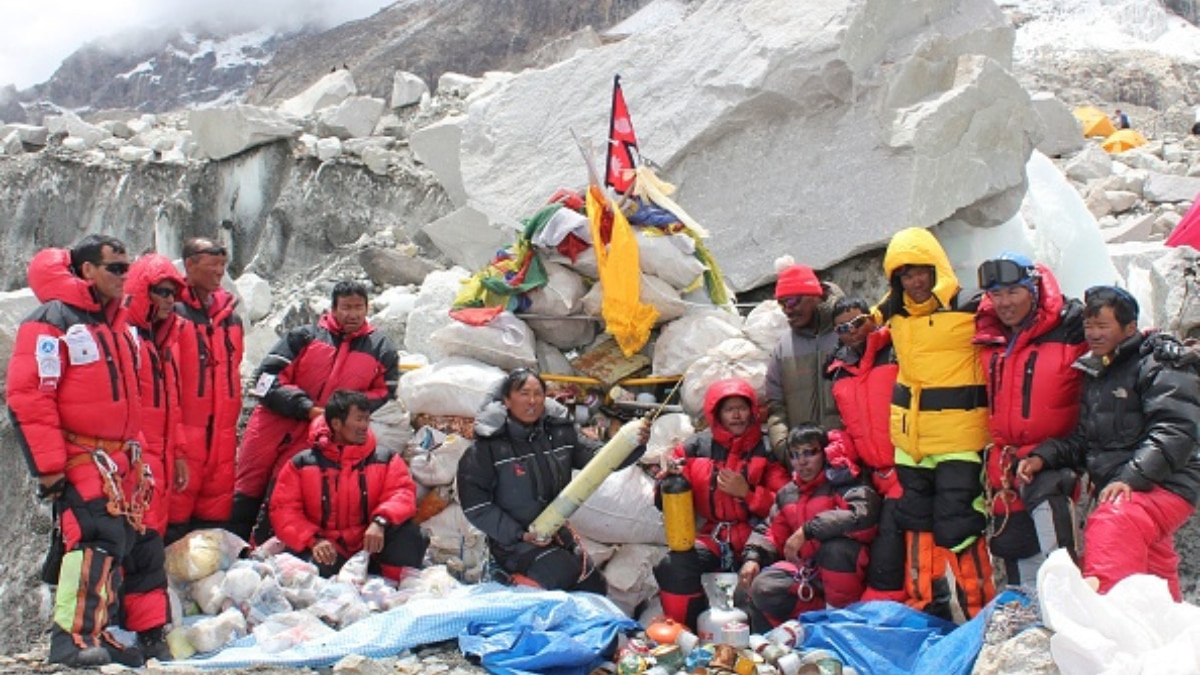The Unheard Echos Of Mt Everest: Litter, Garbage And Dead Bodies- Nepal Army Aims To Clean Up
Each individual produces around 8 Kg of waste, much of which remains on the Mt Everest, posing significant challenges for the overall climbing experience, fragile ecosystem, and local communities.

The world's highest mountain peak, Mt. Everest is part of the 2,400 km long Himalayan range. Known as 'Sagarmatha' in Nepal, meaning 'forehead in the sky,' this has been the dream of mountaineers- a challenge that each of them wishes to undertake. Ever since Edmund Hillary and Sherpa Tenzing Norgay summited this peak on May 29, 1953, Everest has been an inspiration to many people, motivating them to undertake the challenging journey. Apart from being a mountaineer's dream, this expedition is regarded as one of the most dangerous treks worldwide.
If you are also a trekker seeking extreme adventure and dreaming to reach the top of the world, take a moment as we present to you the not-so-beautiful side of the Everest region.
The Sad Tale Of Mt. Everest: Litter, Garbage And Dead Bodies
Situated between Nepal and Tibet, the world’s highest mountain faces significant issues due to the rapid growth in tourism. Approximately 600 to 800 individuals attempt to summit Mount Everest each climbing season, with many leaving litter behind. This in turn affects both climbers' experiences and the local community's way of life.
The Sagarmatha National Park receives 900-1,000 tonnes of solid waste annually, with 50 tonnes found above the Everest Base Camp, which makes the peak called now the 'World’s Highest Garbage Dump.'
Renowned as the world's most mesmerising route for the past 70 years, the Everest Base Camp trek has now started resembling a dumping ground in the 21st century. The area is strewn with tents, empty oxygen bottles, steel bowls, spoons, sanitary pads, paper, and other rubbish accumulated over the years.
According to National Geographic, each individual generates approximately eight kilograms of waste, most of which remains on the mountain, posing significant problems for the fragile ecosystem, the resident wildlife, and the local communities.
Here is a distressing video that has surfaced on Twitter showing the garbage, abandoned tents, and plastic waste thrown at a camp on Mount Everest in the last trekking season.
Disheartening to see the accumulation of garbage at Camp IV on Mt #Everest (8848.86 m). It's high time we address this issue with urgency and commitment. Let's demand stricter regulations, enforcement of clean climbing practices, and effective waste management strategies. Video… pic.twitter.com/KGMlRmUuZk
— Everest Today (@EverestToday) May 28, 2023
Initiative By The Nepal Army:
To address this issue, the Nepal Army has launched a 50-day campaign, called 'Clean Himalaya Campaign-2024', to collect waste from Mt. Everest (8,849 m), Mt Lhotse (8,516 m), and Mt Nuptse (7,816 m). Led by Major Aditya Karki, the team will commence their journey on April 11 and conclude on June 5, 2024, which is World Environment Day.
The campaign aims to combat human-made pollution in the Himalayas and address climate change issues.
In a press conference on Sunday, the Nepal Army announced that the plan is to collect 10 tonnes of waste and up to five dead bodies from the peaks.
During the campaign, 12 trained army personnel will collaborate with 18 Sherpas to collect trash from Everest Base Camp (EBC) up to the Fourth Camp (8000m). Biodegradable waste will be transported to Namche Bazaar for treatment by the Sagarmatha Pollution Control Committee (SPCC), while non-biodegradable waste and deceased bodies will be brought to Kathmandu.
Initiatives To Preserve The Majesty For A Better Trekking Experience:
The government has introduced various rules and regulations over the years.Local NGOs such as Waste Warriors and Healing Himalayas are also actively involved in grassroots waste removal and management efforts. Here are some of them:
- What goes up must come down: One notable initiative introduced in 2014 requires anyone visiting Mount Everest to pay a $4,000 deposit, which is refundable upon their return with eight kilograms of garbage— the average amount produced by a single person during the climb.
- The Sagarmatha Pollution Control Committee (SPCC), an NGO managed by local Sherpa people, has been diligently working to maintain cleanliness in the region. They oversee waste management around Mt. Everest, ensure climbers have the necessary permits, and educate visitors on environmental conservation.
- The Clean Himalaya Campaign-2024: This is a significant effort led by the Nepal Army, which has been conducting cleaning campaigns in the Everest region since 2019. This year marks the fourth such campaign.
- Bring Poop Back Move: In February 2024, the Khumbu Pasanglhamu Rural Municipality, governing body of most of the Everest region, implemented a new rule requiring climbers to bring back their stool from expeditions. Climbers are encouraged to purchase waste disposal bags from the base camp, with the SPCC procuring thousands of bags for climbers, Sherpas, and other staff.

Tips For Mountaineers To Keep The Mountains Clean:
Just as we would not want someone to turn our home into a dumping yard, tourists should also remember that they are visiting the homes of both humans and animals. It's important to ensure that our positive experiences do not have any negative consequences for locals and ecosystems. When exploring mountains, here are few tips one must follow for preserving the environment:
- Remember to pack out all your waste, including food wrappers, tissues, and sanitary pads, and dispose of them properly in the city.
- Reduce your plastic usage by opting for reusable, recyclable, and biodegradable alternatives.
- Be considerate of the wildlife and local habitats by avoiding loud music.
- Carry reusable utensils and water bottle.
- Using public transport helps reduce carbon emissions and minimizes the ecological footprint of your journey.
- Respect for nature and local communities by leaving no trace and striving to leave the environment in better condition by collecting any garbage you encounter along the way and bringing it back with you to the city.
ALSO READ: Visit Whittier: An Alaskan Town Where Everyone Lives Under One Roof






































